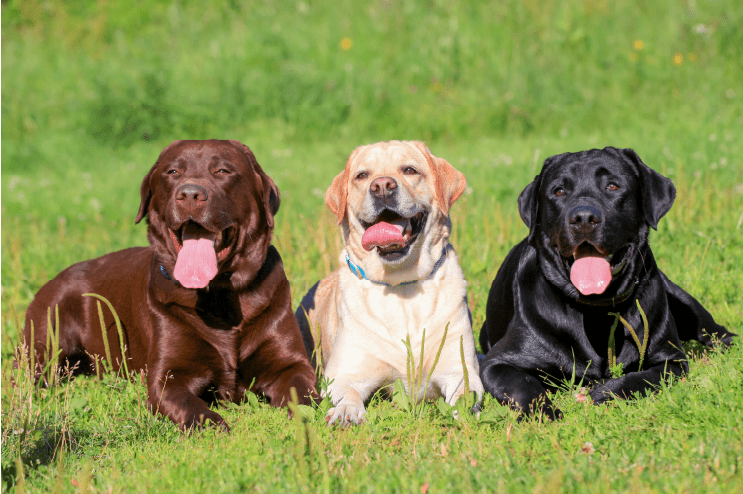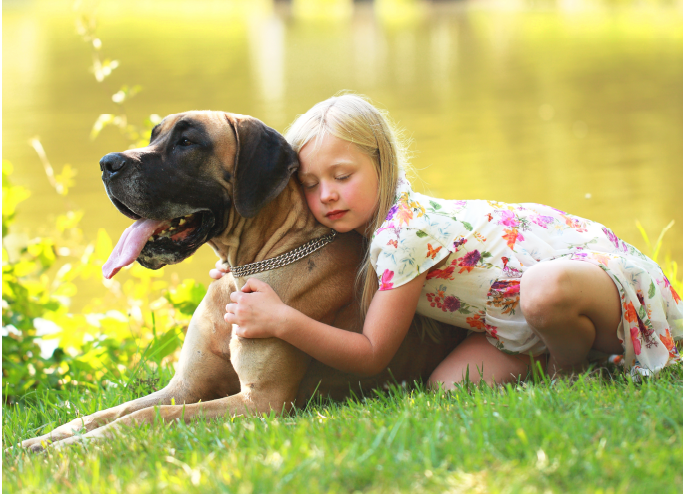Guide to Owning the Biggest Dog Breeds
Introduction
If you think “bigger is better” when it comes to dogs, then this is the blog for you! The biggest dog breeds out there can be amazing companions and, believe it or not, they can be well suited for a variety of lifestyles.
Large dogs tend to do well in a suburban or country living because there is more space for them. However, apartment dwellers can enjoy a big dog too! If you provide your big dog with plenty of daily stimulation and exercise to work off their energy, they will be happy to lounge about your home for hours at a time.
When choosing a large breed dog, consider the history and purpose of the breed. Large breeds are some of the hardest working dogs out there, and with that comes a lot of drive! They will have energy that needs to be channeled into something positive. For example, if you are considering adopting an Oftentimes, failure to do so results in destructive behaviors and/or anxiety in dogs.
Big dogs are amazing companions, and people all over the world can attest that the bigger they are, the more there is to love! However, every dog breed comes with its own set of challenges associated with their care. The following are factors that should be thoughtfully considered before adopting a large-breed puppy.
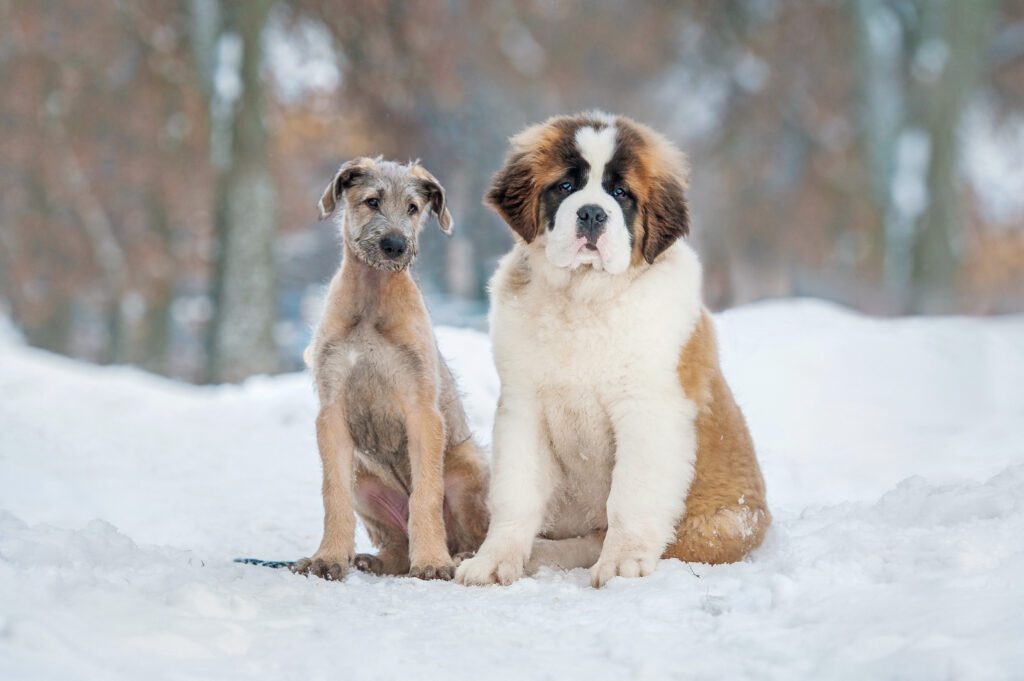 Training
Training
Puppies of all sizes need training and comprehensive socialization, but it is especially important to train giant dog breeds. Bad behaviors that smaller dogs can get away with, like jumping up on people or the counter, pose a much bigger problem with large dogs. They often outweigh people so their size alone is enough reason to work on controlling those behaviors to prevent them from becoming a safety issue.
In addition to their size, consider the traits of the desired breed and whether you will be able to invest in raising and training them properly. Many large breeds were originally bred for hunting or guarding, which makes them both trainable and early socialization crucial. Some breeds, like Mastiffs, can be wary of strangers naturally so providing early positive reinforcement and continuous focus on socialization is extremely important in building their confidence and trust in people. A lack of socialization or utilizing heavy handed training methods can result in a big dog that is insecure and fearful, often leading to acts of aggression.
Ensure you are successful with your big dog by giving them structure, positive training, and exposure to lots of nice people, other puppies, and places! Some make the mistake of being too rough with their big dogs or assuming that their size equals toughness and confidence but truthfully, most of them are big babies that just need our love and guidance!
Expense
The bigger the dog, the bigger the bed, bowls, food, and overall cost. Not only do they consume more food and treats than a smaller dog, but the biggest dog breeds typically require more durable toys and supplies simply because they have a stronger bite-force than small dogs. They also can incur extra expenses at the groomer, vet, or from landlords. Though these dogs can live the apartment life with the right routines, many apartments have weight limits and breed restrictions so keep this in mind when considering the right choice for you.
Bloat
Large dog breeds are more likely to experience bloat than smaller dogs. Bloat (otherwise known as gastric torsion) is what happens when a dog’s stomach expands and then twists. Dogs with deep chests are especially at risk. This is a serious condition and requires immediate medical attention. To avoid bloat, do not allow your dog to eat large meals rapidly. Feed your dog in multiple smaller meals rather than just one meal per day. Consider purchasing a slow-feeder bowl. Lastly, always avoid rigorous exercise directly before or after a meal.
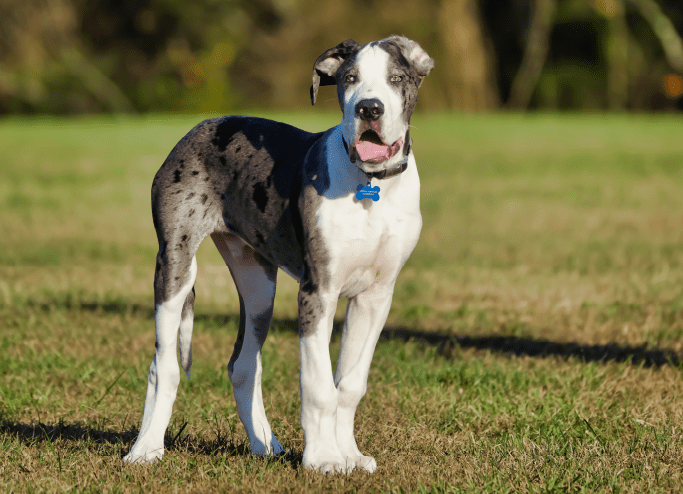 Maturation
Maturation
Though puppies are considered an adult dog after their first birthday, large breed dogs are not done growing until they are about 18 months old. Even slower than their physical growth is their mental maturation, resulting in giant, clumsy puppies for the first couple of years.
Joint Issues
Big dogs are prone to a variety of joint issues, including arthritis, hip dysplasia, and elbow dysplasia. This can particularly affect large-breed dogs who are spayed or neutered before skeletal maturity. It is therefore recommended to avoid sterilizing your dog until 11-14 months of age (or after a female’s first heat). Other preventative measures include choosing a healthy and balanced pet food for your dog and feeding them appropriate amounts and exercising them properly. Being overweight creates increased stress on a dog’s joints, which may have repercussions later in life. Joint supplements are also available as an additive for your dog’s food.
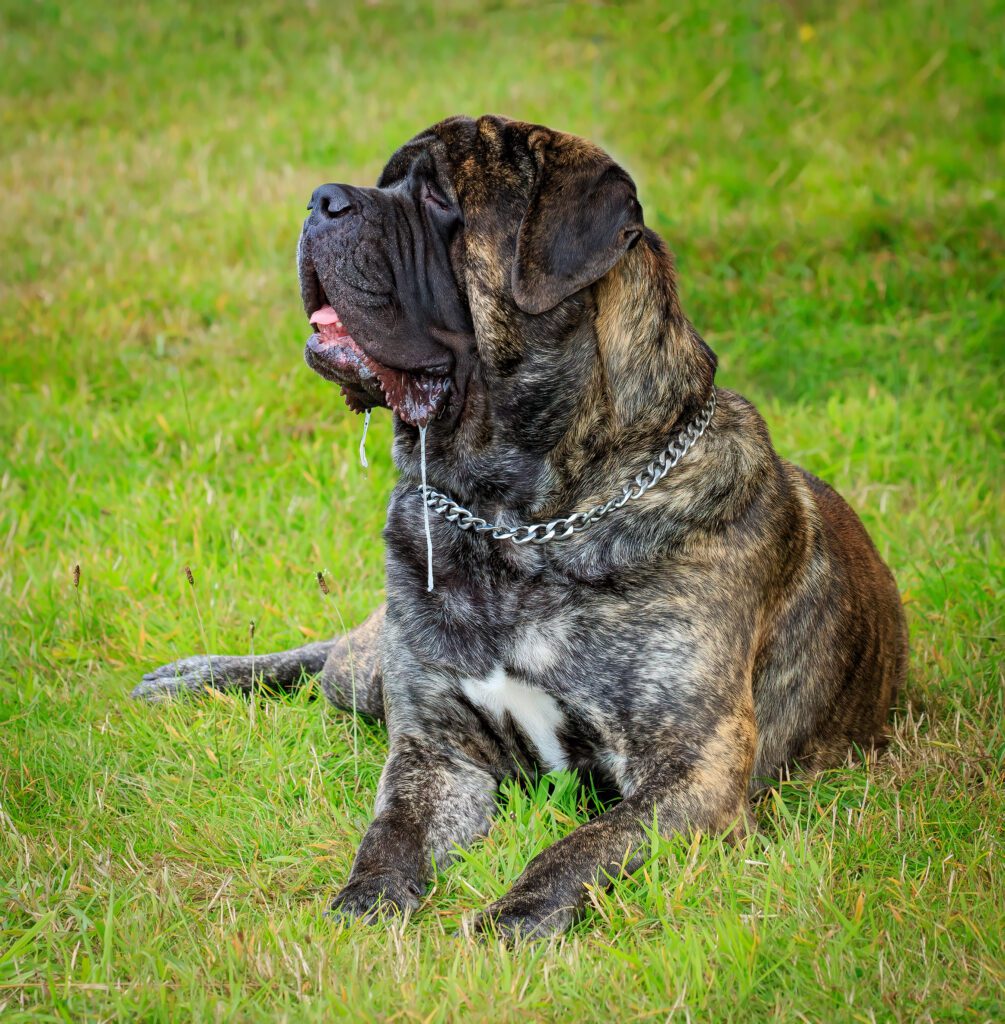 Mess
Mess
All puppies make messes. Some large dogs do not understand their size and can sweep all the contents off a table with a swish of their tail. Begin teaching your dog rear-end awareness early to save yourself some headaches in the future! Apart from no- or low-shedding breeds (such as poodles or poodle mixes), large dogs can also shed quite a bit! Finally, certain giant breeds, such as Mastiffs and Saint Bernards, are notorious droolers. While these drooling dogs are amazing companions, it may be best to invest in some good “drool rags”!
Traveling
Whether it’s a quick jaunt to the store or a full-blown vacation, people and their pets are more inseparable than ever. Unfortunately, large dogs are not as easily portable as their smaller counterparts. They are often not allowed into stores and many pet-friendly rentals have size restrictions or require extra fees for oversized breeds. Taking them on planes can also be more expensive, and they take up more room in the car. One thing you can do to make it a smoother experience when you take your big dog out and about is by doing it early and often as a puppy. Get them to have positive associations with traveling in the car early so that it’s fun! While you still may face logistical barriers in bringing them along on a trip, this will ensure that you are not dealing with a nervous or carsick dog on top of everything!
Lifespan
Perhaps most difficult of all is the simple fact that large-breed dogs do not live as long as smaller ones. Choosing a dog with good genetics and giving your dog proper food and care will help to extend your dog’s lifespan. Ultimately, it is the quality of the time we get with our pets, not only the quantity, that counts. The love that you share with your dog can last long beyond their lifetime, and your bond will always be something to cherish.
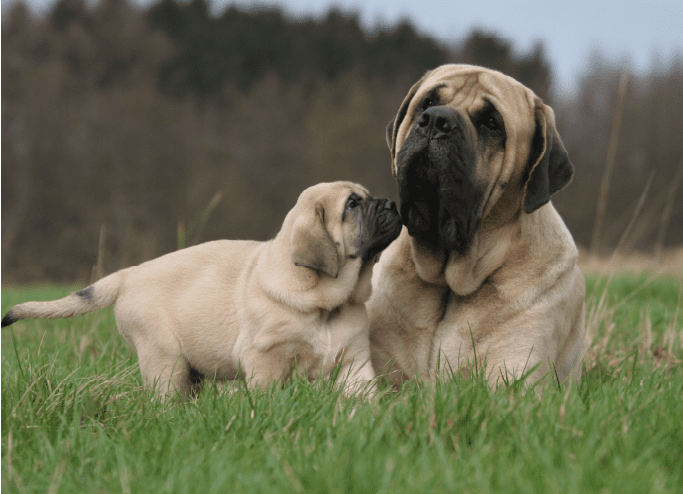
Popular Big Dog Breeds
If you’re ready to sign up for the big dog life, here are 9 popular dog breeds that top the scales:
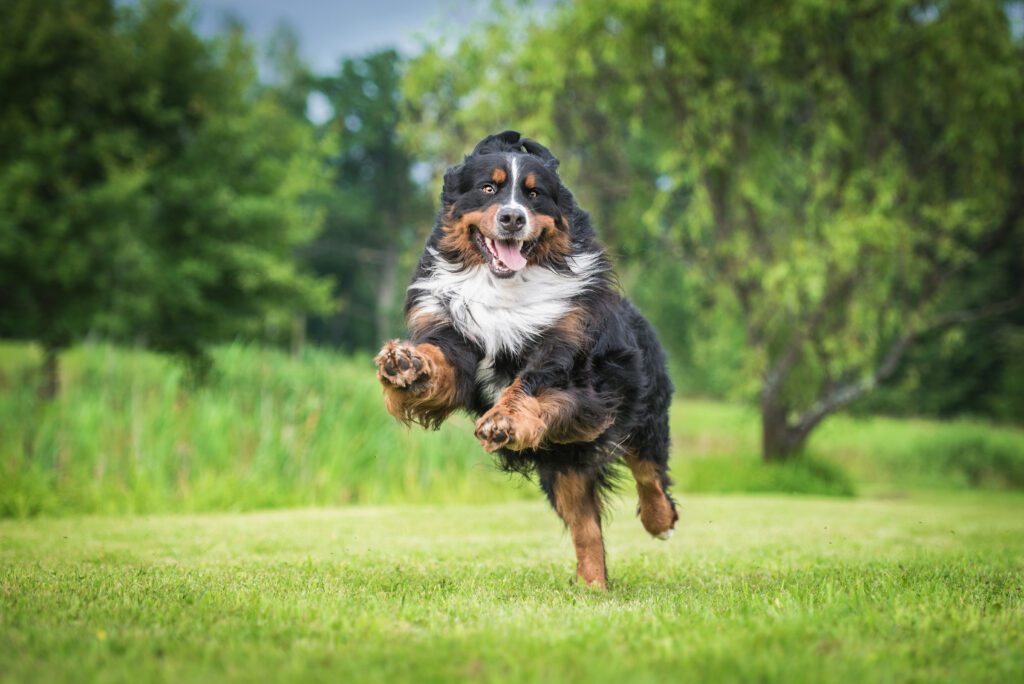 Bernese Mountain Dog
Bernese Mountain Dog
Life expectancy: 6 – 8 years
Height: Male: 25–28 inches, Female: 23–26 inches
Weight: Male: 84–110 lbs, Female: 79–110 lbs
Origin: Switzerland
These strong and striking big dogs are built for hard work and blessed with both a powerful and sweet nature. They are generally amiable and laid-back dogs who are always down for a romp or run for their beloved people. Their hallmark identifiers include a thick, shiny tri-colored coat in deep black, white and rust, framing the spark of intelligence in their dark eyes. These hardy dogs thrive in the winter, as they originated in Switzerland as all-purpose farm dogs who could guard property and drive dairy cattle long distances, earning them the nickname “Cheese Dogs” for protecting the cattle and carts of milk and cheese. The Bernese Mountain Dog is one of four varieties of Swiss mountain dogs. The Bernese’s brain and brawn helped him multitask on the farms and pastures of Switzerland. The Bernese Mountain dog originated in the Swiss mountains. Many 18th century paintings show dogs that look like a Bernese. The breed was named for the Canton of Bern in Switzerland. They were working dogs particularly good at draft work and pulling carts to market. They also were used to drive dairy cattle, to watch over the farm, and as companions to the farmers. By the end of the 19th century, many other working dogs were being imported to Switzerland, which brought the numbers of the Bernese down as workers began to use other types of dogs.
Today, “Berners” are revered as noble and majestic creatures and beloved for their affectionate, beloved nature. These cheerful dogs love children. They are easy to train because they’re very intelligent and natural watchdogs, but not overly dominant. A Bernese Mountain Dog will be your friend for life. Self-confident, alert and good-natured, be sure to socialize well as a puppy. These dogs are slow to mature, acting like puppies longer than other breeds. They are rather friendly with strangers and are generally good with other pets and dogs.
These dogs do well as family pets as they are gentle with children and often become very attached to their humans. Bernese Mountain Dogs need at least a half-hour of moderate daily exercise. They love to enjoy the great outdoors with their family and make excellent hiking buddies. Adventurous owners often bring these dogs camping and backpacking. They would enjoy the job of pulling young children in a cart, and some even participate in carting and drafting competitions! Some other skills to add to the Berner’s resume include agility, herding, obedience, and tracking. Overall, these dogs are strong, sweet and sound temperaments, making them excel in anything you put their mind to.
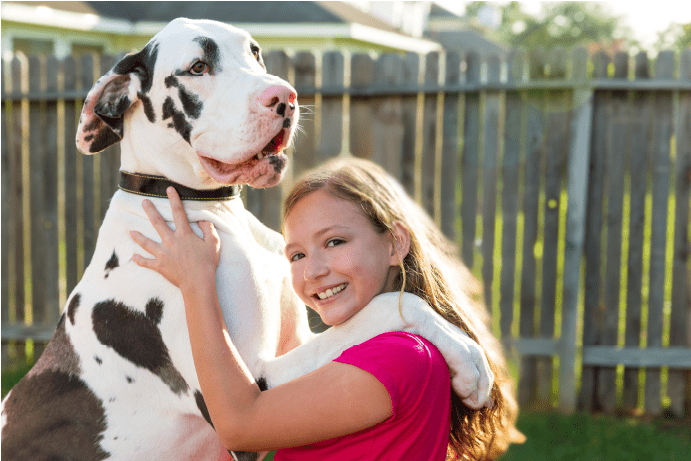 Great Dane
Great Dane
Life expectancy: 8 – 10 years
Height: Female: 28–33 inches, Male: 30–35 inches
Weight: Female: 99–130 lbs , Male: 120–200 lbs
Origin: Germany
The goofy yet elegant giants, the famous “Apollo of Dogs” is an imposingly large breed aptly called the “Great Dane.” While these gentle giants are known for being docile, friendly and reserved, the commitment of owning should not be taken lightly. Weighing in as much as 200 lbs, taking one into your home is an entire lifestyle change. These powerful giants are truly beautiful, noble dogs with the gliding strides of noblemen. Their short, low shedding coats require very little maintenance and come in striking colors, like the black and white patchwork known as the “harlequin” or lighter accents known as “mantles.” These sweet, people-pleasers are also alert guardians who can protect the home simply with the site of their stature!
No one is sure of how or why the Great Dane, which is a German breed, became associated with Denmark. German nobles used Danes to hunt wild boar and would later become famous as protectors of their estate and family. Besides being used as a hunter and guard dog, the Great Dane’s talents also include tracking, watchdog, and carting.
Some health issues that can affect the breed include eye and cardiac diseases, hypothyroidism and autoimmune thyroiditis, and hip dysplasia. Though they have a reputation for being lazy, Danes require some daily exercise appropriate to their age. A nice walk a couple times a day should do the trick, but avoid strenuous activity until they are approximately two years of age to avoid strain on their growing joints.
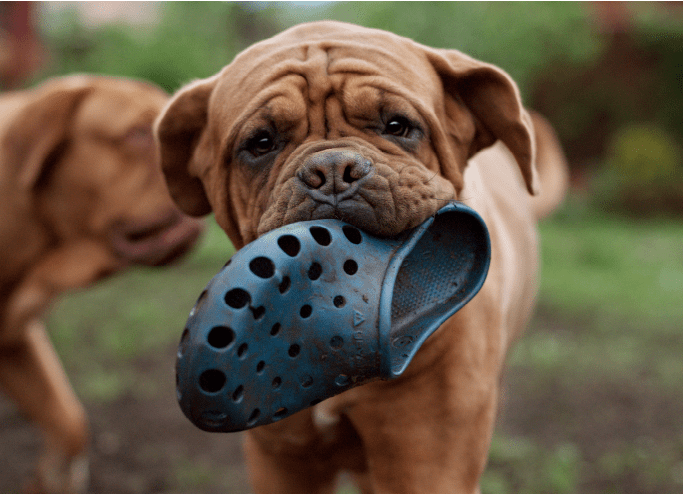 Dogue de Bordeaux
Dogue de Bordeaux
Life expectancy: 5 – 8 years
Weight: Male: 120–140 lbs (54–65 kg), Female: 120–140 lbs (54–65 kg)
Height: Male: 24–26 inches (60–67 cm), Female: 23–26 inches (57–65 cm)
Origin: France
The oldest of the French breeds, the Dogue de Bordeaux (French for “Mastiff of Bordeaux”) was around before France was even established! The Dogue de Bordeaux breed is a relative of the Bullmastiff and Neapolitan Mastiff. It is thought to have existed in France for about 600 years or more, initially guarding estates and hunting big game animals, and later becoming farming dogs or butchers’ dogs. The Dogue de Bordeaux’s first appearance at a dog show was in Paris in 1863, though a breed standard was not established until 1896.
The first Dogue de Bordeaux in the United States was imported in 1959, but wasn’t very popular until 30 years later thanks to its role in the movie “Turner and Hooch”. The breed was admitted to American Kennel Club registration in 2008. Over the Dogue de Bordeaux’s existence, it has served as a war dog, cattle herder, guard dog, hunter of boars, and trained to bait bulls, bears, and jaguars.
You can spot a Dogue de Bordeaux by their richly colored fawn coats, disproportionately large heads featuring a bulldog type of under-jaw and furrowed, wrinkly brow. These hardy, fawn-colored dogs are famously loyal, brave, and vigilant creatures. Despite being a brawny, powerful Mastiff, DDB’s are highly companionable with sweet, sensitive souls. Their proper temperament (encouraged by early and ongoing socialization) is extremely devoted, even-tempered, and loving. They also are known to be stubborn and dominate those who fail to apply firm (not aggressive) training in puppyhood.
Early and on-going socialization and obedience training will lead you to success in raising a well-adjusted French Mastiff. These dogs need to be able to build trust and learn with consistency and positive reinforcement as they can be a bit sensitive, despite their intimidating looks. Harsh and heavy-handed training methods will lead to a fearful Bordeaux, which can be dangerous for a dog of this size!
Dogue de Bordeax ownership is not for the timid or extremely busy person as it takes a firm, consistent methods to raise one of these red-haired beauties. These dogs require moderate exercise to stay healthy and rigorous exercise should be held off until they are about 18 months of age to allow for proper growth and development. It’s also advisable to not let your French Mastiff jump off surfaces much higher than their back or over-exert them on stairs. They are great at swimming and cart pulling and will enjoy having their strength be put to the test!
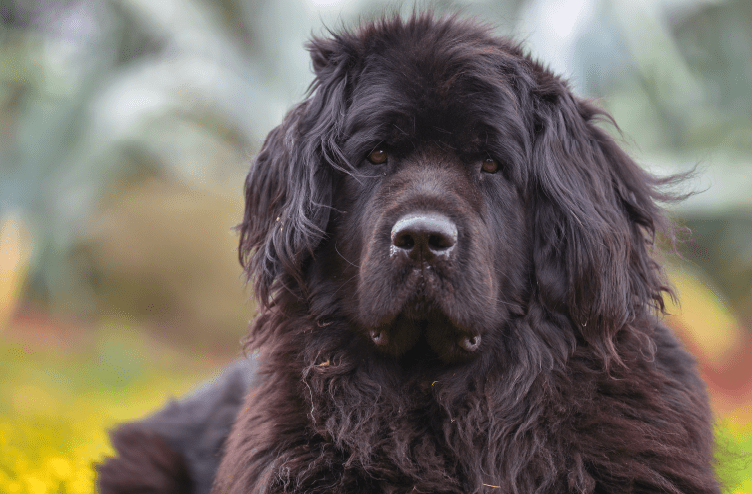 Newfoundland
Newfoundland
Life expectancy: 8 – 10 years
Height: Male: 27–28 inches, Female: 25–26 inches
Weight: Male: 140–180 lbs, Female: 120–140 lbs
Origin: Newfoundland and Labrador
The massive Newfoundland is an intelligent, large, powerful working dog of dignified nature. These devoted dogs are famously loving companions and they’ve earned the reputation of being patient, watchful “nanny dogs.” Their long, shiny outer coats wick away water, making them the perfect rescue dogs for water emergencies. These heroic giants can grow up to 140 pounds for females and males can reach 200 pounds!
The Newfoundland will serve you with great loyalty, love, and dedication with a keen sense of connection your human emotions. They make great watchdogs because they will place themselves between their owner(s) and an intruder, but they are not aggressive in nature. It’s their protection instinct. Despite their working breed history, some Newfies can be lazy and will need just enough exercise to allow them to burn off steam so they can go back and lay down. They love to be outside and enjoy hiking and swimming. Newfoundland pups that are raised with plenty of outings and socialization will love going out in nature with you. They can usually be introduced to swimming around the age of four months.
Newfies are among the biggest dogs in the world and their stature and strength give them power to save lives. Newfoundlands excel in water rescue and love to be outside. In addition to their life-saving abilities, these dogs are devoted family companions. A “tell-tail” quality of the Newfoundland is their affinity for children. Their trusting hearts respond well to gentle guidance, making them very trainable. When socialized early, your Newfoundland will show great patience and kindness toward other pets and children.
Newfoundland puppies greatly benefit from a good deal of activity and early socialization. They are generally eager to please and trainable. Affectionate and somewhat sensitive, these dogs do best with gentle guidance, and positive or balanced training. Provide Newfie puppies with early socialization and training classes and lots of human contact and socialization.
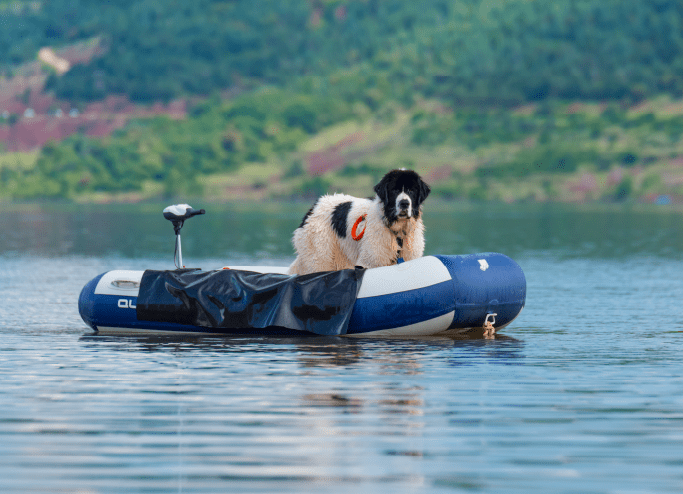
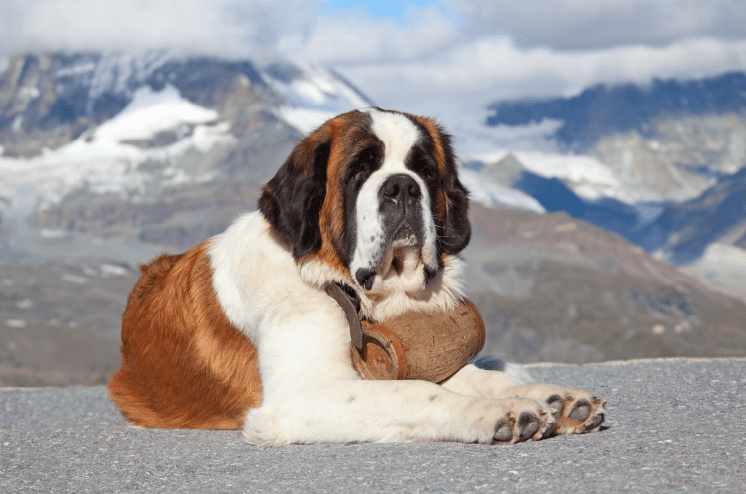 Saint Bernard
Saint Bernard
Life expectancy: 8 – 10 years
Weight: 140 – 180 lbs (Male), 120 – 140 lbs (Female)
Height: Male: 28–35 inches , Female: 26–31 inches
Origin: Switzerland
This widely adored genial giant from the Swiss Alps is one of the world’s most well-known breeds. They are patient, friendly, gentle and loving dogs who also have the “nanny dog” reputation with children. They are extraordinarily large and muscular with a powerful stature and huge heart to match. Their gigantic heads feature a wrinkled brow, short muzzle highlighted by flashes of white, giving a striking contrast to their friendly eyes.
Saint Bernards are typically seen as a tri-colored dog of reddish-brown, with white patches and black masks and markings. They come in long and short-haired varieties, both which require regular maintenance of daily brushing with shedding seasons twice a year.
Saints are happiest when doing activities with their families and will be glad to tag along on walks, hikes, and outings. Much like the Newfie, these dogs can enjoy down time just as much as going out. Be ready to get stopped a lot of you are taking one of these most beautiful and largest dog breeds out and about!
Early, on-going socialization and dedicated training is highly necessary for a Saint Bernard. Dogs of this size need to be taught early on how to have manners and not jump on people since they will grow to be larger than some! Saints will be eager to please their owners and generally easy to teach what is expected of them. Give them plenty of attention along with boundaries to ensure your Saint is a well-balanced dog. It is important to note that these large dogs can develop protective tendencies with their owners so putting forth effort to build trust with new people can go a long way.
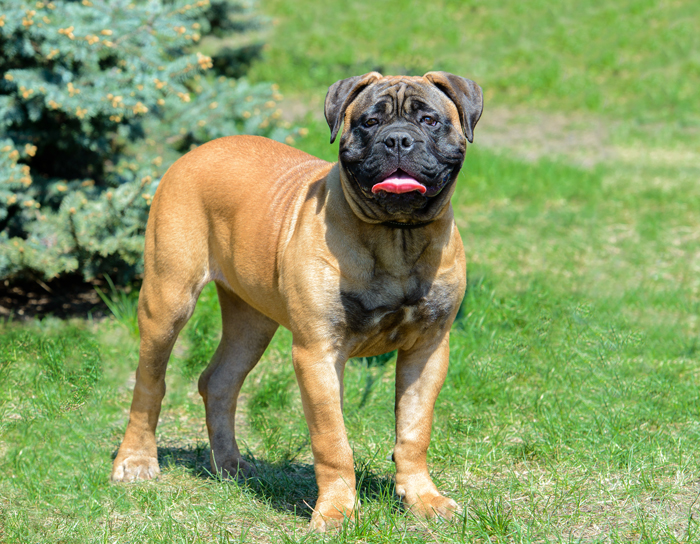 Bullmastiff
Bullmastiff
Life expectancy: 8 – 10 years
Height: Male: 25–27 inches, Female: 24–26 inches
Weight: Male: 110–130 lbs, Female: 99–120 lbs
Origin: England
Bullmastiffs are fearless giants made of pure muscle and devotion. These dogs are a cross between the Bulldog and Mastiff, and though they are not as large as the Mastiff, they made for some beefy and loyal guardians that historically pursued illegal poachers in Old England. Standing at 27 inches at the shoulder and weighing in 100-130 pounds, the Bullmastiff is a fantastic protector as well as family companion. In addition to their size, their broad heads, dark eyes, and powerful muzzle present an alert, confident dog that will fight for their family. Their coats can be fawn, brindle, or red and require little maintenance.
These dogs are hardy and reliable, and being a guarding dog, it is even more important to begin training and socialization early while the puppy is small enough to control and highly impressionable. To become a guard dog, they must be mentally and physically sound and breeders should screen their breeding stock for cardiac issues, hip and elbow dysplasia, and eye issues.
Some Bullmastiffs are more active than other large breeds, so moderate exercise such as brisk walks and playing outdoors is important for them. Be careful not to overexercise these puppies as they grow and be sure to give them early and ongoing socialization and training. This breed is strong willed and dog owners should be instilling training regiments early in life. Rules and routines established early help a pup grow up nicely.
Additionally, Bullmastiffs can excel in categories of agility, obedience and even scent work! Begin training early and participating in activities to help build that lifelong bond and respect between a dog and owner.
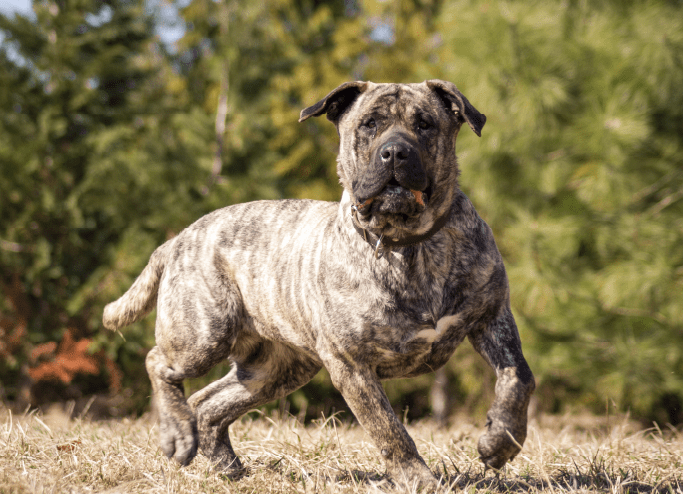 English Mastiff
English Mastiff
Life expectancy: 6 – 12 years
Weight: Female: 120–170 lbs, Male: 160–230 lbs
Height: Female: 28–36 inches, Male: 28–36 inches
Origin: England
The Mastiff is a very massive, powerful, muscular dog commonly known as a gentle giant. Don’t let the size fool you, these dogs are lovers! Dominance levels do vary, even within the same litter, and they are a born guard dog even though they rarely bark. It’s in the Mastiff’s nature to defend its territory and family but they are more of a silent guard.
Self-confident and watchful, English Mastiff puppies are patient and considered excellent with children. Intelligent, calm, even-tempered and docile, this breed is very large and heavy. They respond well to firm, but gentle, patient training. They love to please and need a lot of human leadership. Socialize them well to prevent them from becoming aloof with strangers.
Mastiffs have short coats that only require a little brushing however you will want to regularly inspect and clean the wrinkles in a Mastiffs face. Though they are not quite a wrinkly and droopy as the Neopolitan Mastiff, these areas should be kept clean to avoid infection. Most Mastiff owners quickly learn to keep a cloth handy to wipe off drool from the dogs face – or themselves!
Owners need to be firm, calm, consistent, confident with an air of natural authority to communicate to the Mastiff that dominance is not unacceptable. If socialized with proper leadership it will get along well with other dogs. They can be somewhat difficult to train. The objective in training this dog is to achieve pack leader status. It is a natural instinct for a dog to have an order in its pack. They require relatively low exercise but benefit greatly from regular play and daily walks.
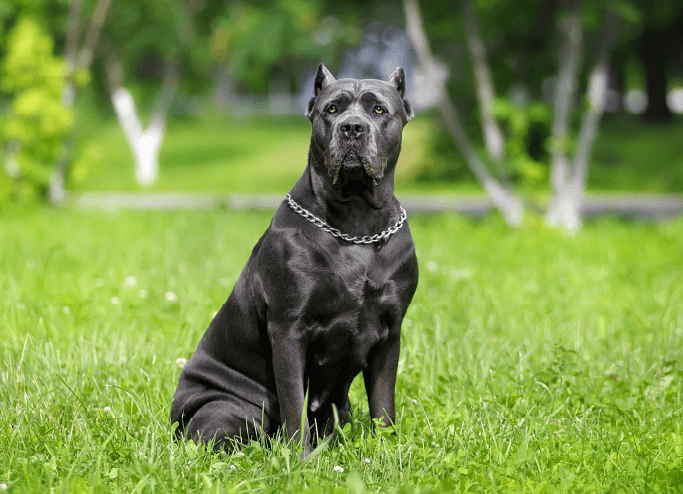 Cane Corso
Cane Corso
Life expectancy: 10 – 12 years
Height: Female: 23–26 inches, Male: 24–28 inches
Weight: Female: 88–99 lbs, Male: 99–110 lbs
Origin: Italy
The Cane Corso, also known as an Italian Mastiff, is a noble, majestic, and has powerful in presence. It is a muscular and large-boned breed. One of two Italian “mastiff” dogs that descended from the Roman canis Pugnaces, the breeds name derives from the Latin “Cohors” which means “Guardian” and “Protector.” The breed’s coat is short, coarse and thick in order to be perfectly waterproof. It can be black, gray, fawn or red, with brindle variations and a black or gray mask also acceptable. Make no mistake: This is a whole lot of dog, both physically and temperamentally. This breed is not for everyone. They’re smart, trainable, eager to please, versatile, docile and intensely loyal with their humans.
These “body guard” dogs stand at about 28 inches at the shoulder, weighing in over 100 pounds on average with a large, prominent head and muscles rippling through their body. There is no denying these dogs are intimidating creatures! Their air of cool competence and alertness provides for a line of defense against intruders. This power is something to be harnessed and driven to prevent one from owning an unwitting owner. Diligent training and socialization with positive reinforcement and firm rules will set you up for success with a Corso.
To own a Cane Corso is not for the faint-hearted. Not only does this dog require serious exercise, but they will also require a great deal of training and early socialization. They make great companions (especially as exercise partners), guard dogs, and love to have a job. As with all dogs as strong as the Cane Corso, they must learn early on to trust humans and have manners. Many Corsos can be protective and dominant so building that trust and understanding with them from the get-go is a must for this breed. Despite their intimidating appearance, these dogs are full of love and will respond the best to positive training and rewards much better than harsh training methods.
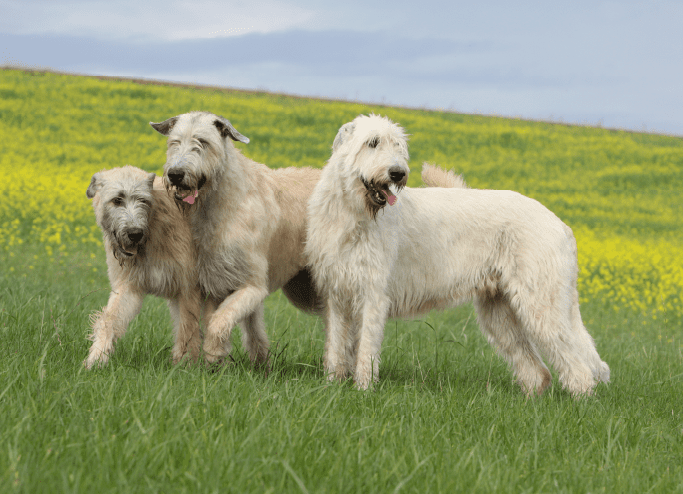 Irish Wolfhound
Irish Wolfhound
Life expectancy: 6 – 10 years
Height: Female: 26–30 inches, Male: 28-35 inches
Weight: 90–160 lbs
Origin: Ireland
Ladies and gentleman, weighing in at the top of the list of biggest dogs in the world is the tallest dog breed; an Irish Wolfhound! The calm and dignified Irish Wolfhound is among the most agreeable and easy-going companions despite being beautiful beasts originally breed for big-game hunting!
These gigantic dogs are muscular and graceful, built for speed like a Greyhound with an intimidating height! A male Irish Wolfhound can stand at about 3 feet just at the shoulder and weigh up to 180 pounds. Their rough, wiry coats come in many colors like grey, white, red, black and fawn.
Though they are large, they are far too peaceful to be guard dogs. Irish Wolfhounds benefit from long walks and opportunities to play, but due to their hunting instincts, only let them free roam in secure areas! They will thrive with plenty of space to play and exercise, but as they age they typically become couch potatoes.
Wolfhound puppies take a great deal of time to mature; up to 18 months! Do not over-exercise them as puppies and be sure to give them lots of stimulation and socialization. They can be very destructive puppies and possibly even prone to self-injury as they hit growth spurts. Never leave an Irish Wolfhound puppy alone for too long. They are intelligent and will want to be trained and worked with. They crave quality time with their family and seem to possess an emotional intuition, making them remarkable therapy dogs.
Conclusion:
Owning one of the biggest dog breeds in the world is definitely not for the weak! If you are interested in the big dog life but want to step it down a notch, you might consider some of the breeds below. Many of these dogs are bigger without being overwhelmingly large. Dogs like the Labrador Retriever or Labrador Mixes can range from 60-90 lbs. These dogs do have a great deal of similarities to our largest dog breed list but will be just a weight class or two lower.
No matter the size of your canine companion, their impact is going to be tremendous! Dogs make life better and having a pet that encourages structure and exercise in your life has some serious health benefits! In fact, dog owners are more likely to live longer lives.
Some Other Big Dogs to Check Out:
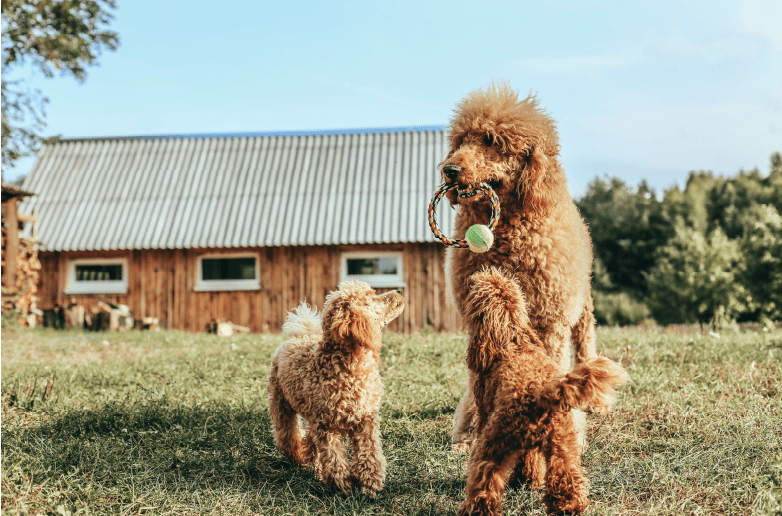 Standard Poodle
Standard Poodle
The athletic and aristocratic Poodle comes in a variety of sizes, with “Standard Poodle” topping the charts at roughly 50 to 75 pounds. Poodles have famously soft, curly and non-shedding coats, making them both a great pet for those with allergies and awesome clients for groomers. Poodles are extremely intelligent and energetic and will do best with lots of training and exercise.
Learn more about the Standard poodle here.
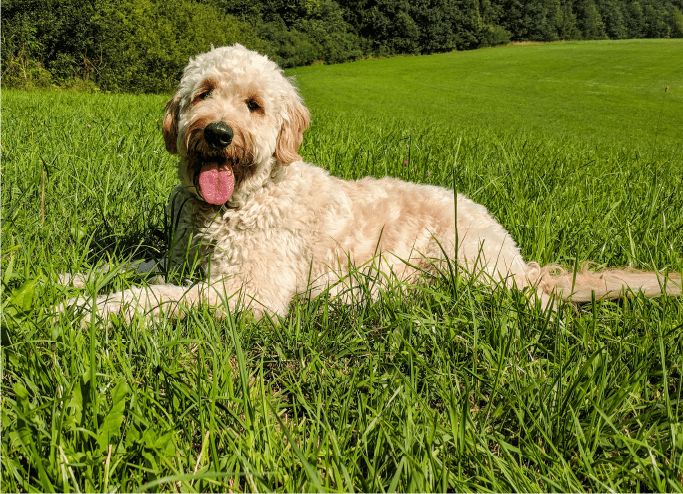 Goldendoodle/Labradoodle
Goldendoodle/Labradoodle
Poodle mixes are sweeping the nation for their hypoallergenic qualities and lovable personalities! Combining the happy-go-lucky nature of a Lab or Golden Retriever with an smart, driven poodle results in a pretty cool dog!
There’s a reason you see these dogs everywhere in America – they are just plain awesome.
Learn more about the Goldendoodle or the Labradoodle!
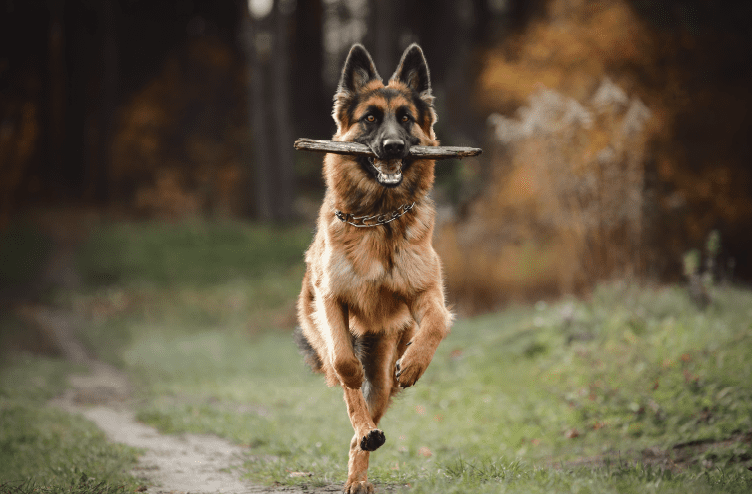 German Shepherd Dog
German Shepherd Dog
German Shepherds are extremely driven and smart dogs who will be happiest with a “job” to do. They require a great deal of training and exercise and will be anxious when left alone. These loyal, watchful dogs need plenty of training and socialization. They generally reach 60-80 lbs. in males and females 45-70 lbs.
Learn more about German Shepherds.
 Labrador Retriever / Golden Retriever
Labrador Retriever / Golden Retriever
Labrador Retrievers and Golden Retrievers are the one of the most popular family dogs of all time, for good reason! They have famously sweet temperaments and tolerance to children. Retrievers might be smaller than the biggest dogs in the world, but they still are a lot of work in the training and exercise department! Be sure you can meet the physical demand of owning one before moving forward because they grow fast.
Learn more about the Labradors and Goldens.
